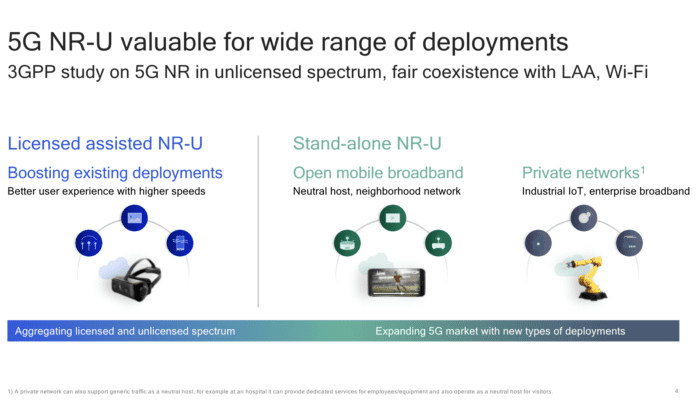5G NR-U can serve operator, enterprise and industrial demands
In the context of LTE, the use of Licensed Assisted Access to aggregate licensed and unlicensed spectrum bands is key to helping operators deploy gigabit LTE. In fact, research from Qualcomm suggests that 90% of global operators can deliver a gigabit-class cellular experience using LAA and 10 megahertz of licensed spectrum. With the commercialization of networks based on the 5G New Radio standard poised to take off throughout 2019, what’s the vision for using unlicensed spectrum with 5G NR?
Dean Brenner, Qualcomm’s senior vice president of spectrum strategy and technology policy, discussed the role of unlicensed for LTE and 5G NR at the 4G/5G Summit in Hong Kong Last month. “About five years ago at Qualcomm, we took a look and said, ‘Everybody knows the limitations of Wi-Fi.’ Could we develop some technology that would actually perform better in unlicensed spectrum?” That question prompted the R&D that led to LTE-Unlicensed and LAA.
“Late in the game with 4G,” Brenner said, “we basically made some changes on top of the existing 4G technology to optimize 4G to use unlicensed spectrum. But it was not built from the ground up for unlicensed spectrum. What we’re trying to do with 5G is say…we don’t want to have to come late to the game. We know unlicensed spectrum is very important.”
He highlighted three deployment scenarios for 5G in unlicensed spectrum. First is the same paradigm as LAA–operators aggregating licensed and unlicensed frequencies to boost capacity. A standalone 5G NR-U deployment could support neutral host deployments and enable private networks for enterprise and industrial purposes, including broadband and internet of things projects.
5G NR-U is also something R&D specialist InterDigital is thinking about. Doug Castor, senior director of InterDigital Labs, identified 60 GHz as an important band for 5G in unlicensed. “This is something we’re starting to talk to our partners about,” he told RCR Wireless News. “We see lots of opportunities for taking NR into 60 GHz. It can reuse some of the phased array equipment that has been developed for Wi-Gig.”
Wi-Gig is based on the IEEE 802.11ad standard, and uses 60 GHz to deliver multi-gigabit Wi-Fi.
Castor’s colleague Fred Schreider, director of engineering, said, “The other interesting area is private networks for industry and enterprises. Oil and gas refineries need connectivity in a big area. They want a private network. They want the things a real network does, like a 3GPP network as opposed to Wi-Fi. I think NR-U is going to be interesting for factories or oil and gas refineries.”

